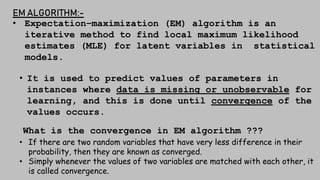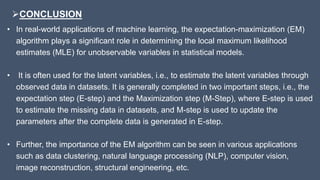The document provides an overview of the EM algorithm. It begins by explaining the need for the EM algorithm when parameters and data points are unknown. It then defines the EM algorithm as an iterative method for finding maximum likelihood estimates for latent variables in statistical models. The key steps of the EM algorithm are the Expectation step (E-step) which estimates missing values, and the Maximization step (M-step) which updates parameters based on the estimated data. The algorithm repeats these steps until convergence is reached. Applications of the EM algorithm include data clustering, mixture modeling, and estimating latent variables in general.


![Lets start this with very basic question:
I tell u three data points [1,2,x] are the draws from
normal distribution N(1,1).
Whats the best guess for x ???
Obiviously best guess for x will be the mean ie 1.
if tell u three data points [0,1,2] are the draws
from normal distribution N(µ,1).
Whats the best guess for µ ???
Again best guess for µ will be the average ie 1.
Why there is need for EM algo](https://image.slidesharecdn.com/mlpresentation1-230419113919-80abb20a/85/ML-PRESENTATION-1-pptx-3-320.jpg)
![ Now if i give u three data points [1,2,x] are the
draws from normal distribution N(µ,1).
Whats the best guess for x and µ ???
In this case we dont know the parameter that generate the
data and also don’t know the data point.
Here We don’t have two pieces of information
simultaneously.
I need one to find another . This gave us the spirit of EM Algorithm](https://image.slidesharecdn.com/mlpresentation1-230419113919-80abb20a/85/ML-PRESENTATION-1-pptx-4-320.jpg)











![Now lets ge t the question we have discussed earlier
Given three data points [1,2,x] are the draws from normal
distribution N(µ,1).
Whats the best guess for x and µ ???
Using the EM algorithm
Guess x = 0 µ = 1
x = 1
x = 4/3 µ = 13/9
µ = 4/3
.
.
.
.
.
.](https://image.slidesharecdn.com/mlpresentation1-230419113919-80abb20a/85/ML-PRESENTATION-1-pptx-16-320.jpg)





